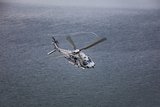Osprey's provide MEUs with a new tool for humanitarian aid missions
When calamity strikes and only a trail of desolation remains, no other Marine Air Ground Task Force is better prepared to support a full spectrum of Humanitarian Aid missions than a Marine Expeditionary Unit.
24th Marine Expeditionary Unit Marines and Sailors completed more than six months of training perfecting the planning and execution of humanitarian aid missions for this deployment, but this time with a tool never before used during an HA mission, the MV-22 Osprey.
This is the first time the 24th MEU deployed with MV-22 Ospreys, these part of its air combat element Marine Medium Tilt Rotor Squadron 162 (Reinforced). VMM-162 (Rein) provides 12 MV-22 Ospreys, four CH-53E Super Stallion heavy lift /transport helicopters, three UH-1N Huey helicopters and close air support jets and attack helicopters.
We provide a lot of flexibility and movement as an expeditionary unit; however, without the aviation element you cannot get a lot of personnel and supplies to shore said Lt. Col. Robert C. Sherrill, commanding officer, VMM-162 (Rein), 24th MEU.
"The Ospreys provide a greater lift, they're faster, and go farther (than its predecessor and other similar aircraft). Those (characteristics) are powerful in a situation when the time is of the essence, whether it's taking casualties back to the ship for medical attention or relaying supplies," said Sherrill. "This aircraft provides a lot of depth as a (MEU) aviation element.
The Osprey is a vital tool in overcoming the barrier between where aid supplies and personnel are located and where they are needed, making the Osprey a prized asset for long-distance aerial transportation.
"If we were to have a mission and needed to enter difficult locations, the MV-22 gives us the flexibility to do so from ship or land and from great distances away and get what's needed to a landing zone where other forms of transport cannot access," said Capt. Zachary R. Webb, MV-22 Osprey pilot, VMM-162 (Rein), 24th MEU. "The Osprey has a capability it brings to the fight that (other aircrafts) would be limited in."
The Osprey's new airframe opens a new path to providing aid in terrain that immobilizes ground transportation vehicles.
"The Osprey's hydraulic system basically converts an airplane to helicopter, which allows he aircraft to fly faster and futher than other helicopters and Marines to do 'hot-drops' in any location," said Pvt. Travis A. Keys, airframer, VMM-162(Rein), 24th MEU. "The Osprey lands and takes-off as a helicopter, making it easier to land in nearly any location without a runway and with much more load room than the Marine Corps' (other ) helicopters."
The MV-22 Osprey interior is capable of transporting 24 passengers or 12 aid litters (stretchers) that makes the aircraft a versatile mechanism for moving supplies, relief workers and medical personnel to disaster areas or casualties to health facilities.
"Logistically, it's faster, more efficient more efficient moving supplies and personnel by air," said Senior Chief Petty Officer Christopher D. Olinger, medical senior enlisted leader, 24th MEU. "You can't coma ashore with everything you may need for every possible contingency and if we don't have the told required we cannot succeed. Having that air support asset we can tap into is essential."
The quantity of supplies and/or personnel required is determined on a mission-to-mission basis and MV-22 staff and crews trained hand-in-hand with Combat Logistics Battalion 24, the MEU's logistical lifeline that provides support and sustains combat and humanitarian forces.
"Our Marines trained cinsistently with the Ospreys to load, unload personnel and equipment in order to get the gear where it needs to be, and we've learned that speed is a significant factor," said Sgt. William K. Weaver, platoon sergeant, Landing Support Detachment, CLB-24, 24th MEU. "When it comes to internal loads, the Osprey can go further and faster with the goods we load."
The 2,300 Marines and Sailors who comprise the 24th MEU are poised to use the full arsenal of its assets if called upon for support while located in the U.S. Southern Command area of operations.
By Sgt. Alex C. Sauceda, 24th MEU - United States Marine Corps
More from Defence Helicopter
-
![Germany to send WS-61 Westland Sea King helicopters to Ukraine]()
Germany to send WS-61 Westland Sea King helicopters to Ukraine
Germany has committed to sending Ukraine six of its 21 retiring WS-61 Westland Sea King multirole, amphibious helicopters.
-
![Boeing secures $271 million to advance modernisation of US Special Operations' MH-47G Chinook]()
Boeing secures $271 million to advance modernisation of US Special Operations' MH-47G Chinook
Boeing has clinched a major contract modification to further its backing of the US Special Operations Command’s MH-47G Chinook aircraft modernisation effort.
-
![Dubai Airshow 2023: South Korean homegrown helicopters make international debut]()
Dubai Airshow 2023: South Korean homegrown helicopters make international debut
Two KAI helicopters, the KUH-1E utility helicopter and the Light Attack Helicopter (LAH), have taken centre stage at the Dubai Airshow 2023.
-
![Italian Navy receives final NH90 helicopter]()
Italian Navy receives final NH90 helicopter
The Italian Navy now boasts a fleet of 56 NH90 helicopters comprising 46 SH-90As and 10 MH-90As.
-
![Argentina seeks AW109 and CH-46 Sea Knight helicopters]()
Argentina seeks AW109 and CH-46 Sea Knight helicopters
The Argentinian Air Force (FAA) and the Argentinian Naval Aviation Command (COAN) are looking for options to upgrade their helicopter fleets.
-
![DSEI 2023: Lockheed to produce about 40% of Black Hawks on UK soil if it wins NMH contest]()
DSEI 2023: Lockheed to produce about 40% of Black Hawks on UK soil if it wins NMH contest
Lockheed Martin promises a boost to the British job market and export opportunities, while strengthening ties with Poland and positioning the UK for a future in rotorcraft technology in the event of a New Medium Helicopter competition triumph.


























